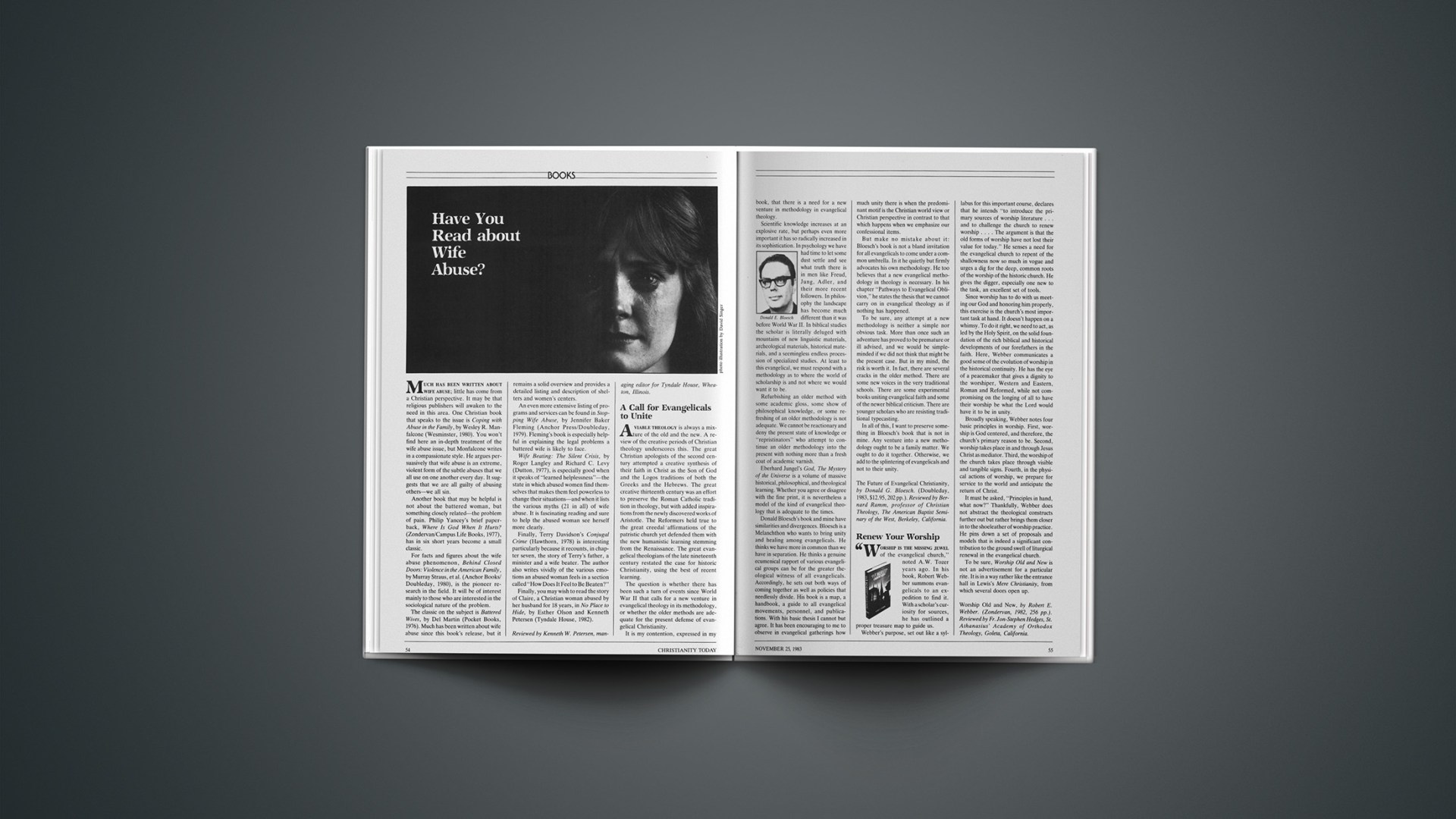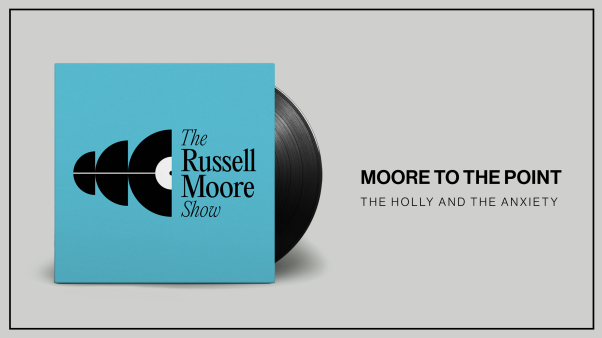Have You Read About Wife Abuse?
Much has been written about wife abuse; little has come from a Christian perspective. It may be that religious publishers will awaken to the need in this area. One Christian book that speaks to the issue is Coping with Abuse in the Family, by Wesley R. Manfalcone (Wesminster, 1980). You won’t find here an in-depth treatment of the wife abuse issue, but Monfalcone writes in a compassionate style. He argues persuasively that wife abuse is an extreme, violent form of the subtle abuses that we all use on one another every day. It suggests that we are all guilty of abusing others—we all sin.
Another book that may be helpful is not about the battered woman, but something closely related—the problem of pain. Philip Yancey’s brief paperback, Where Is God When It Hurts? (Zondervan/Campus Life Books, 1977), has in six short years become a small classic.
For facts and figures about the wife abuse phenomenon, Behind Closed Doors: Violence in the American Family, by Murray Straus, et al. (Anchor Books/Doubleday, 1980), is the pioneer research in the field. It will be of interest mainly to those who are interested in the sociological nature of the problem.
The classic on the subject is Battered Wives, by Del Martin (Pocket Books, 1976). Much has been written about wife abuse since this book’s release, but it remains a solid overview and provides a detailed listing and description of shelters and women’s centers.
An even more extensive listing of programs and services can be found in Stopping Wife Abuse, by Jennifer Baker Fleming (Anchor Press/Doubleday, 1979). Fleming’s book is especially helpful in explaining the legal problems a battered wife is likely to face.
Wife Beating: The Silent Crisis, by Roger Langley and Richard C. Levy (Dutton, 1977), is especially good when it speaks of “learned helplessness”—the state in which abused women find themselves that makes them feel powerless to change their situations—and when it lists the various myths (21 in all) of wife abuse. It is fascinating reading and sure to help the abused woman see herself more clearly.
Finally, Terry Davidson’s Conjugal Crime (Hawthorn, 1978) is interesting particularly because it recounts, in chapter seven, the story of Terry’s father, a minister and a wife beater. The author also writes vividly of the various emotions an abused woman feels in a section called “How Does It Feel to Be Beaten?”
Finally, you may wish to read the story of Claire, a Christian woman abused by her husband for 18 years, in No Place to Hide, by Esther Olson and Kenneth Petersen (Tyndale House, 1982).
Reviewed by Kenneth W. Petersen, managing editor for Tyndale House, Wheaton, Illinois.
A Call For Evangelicals To Unite
Aviable theology is always a mixture of the old and the new. A review of the creative periods of Christian theology underscores this. The great Christian apologists of the second century attempted a creative synthesis of their faith in Christ as the Son of God and the Logos traditions of both the Greeks and the Hebrews. The great creative thirteenth century was an effort to preserve the Roman Catholic tradition in theology, but with added inspirations from the newly discovered works of Aristotle. The Reformers held true to the great creedal affirmations of the patristic church yet defended them with the new humanistic learning stemming from the Renaissance. The great evangelical theologians of the late nineteenth century restated the case for historic Christianity, using the best of recent learning.
The question is whether there has been such a turn of events since World War II that calls for a new venture in evangelical theology in its methodology, or whether the older methods are adequate for the present defense of evangelical Christianity.
It is my contention, expressed in my book, that there is a need for a new venture in methodology in evangelical theology.
Scientific knowledge increases at an explosive rate, but perhaps even more important it has so radically increased in its sophistication. In psychology we have had time to let some dust settle and see what truth there is in men like Freud, Jung, Adler, and their more recent followers. In philosophy the landscape has become much different than it was before World War II. In biblical studies the scholar is literally deluged with mountains of new linguistic materials, archeological materials, historical materials, and a seemingless endless procession of specialized studies. At least to this evangelical, we must respond with a methodology as to where the world of scholarship is and not where we would want it to be.
Refurbishing an older method with some academic gloss, some show of philosophical knowledge, or some refreshing of an older methodology is not adequate. We cannot be reactionary and deny the present state of knowledge or “repristinators” who attempt to continue an older methodology into the present with nothing more than a fresh coat of academic varnish.
Eberhard Jungel’s God, The Mystery of the Universe is a volume of massive historical, philosophical, and theological learning. Whether you agree or disagree with the fine print, it is nevertheless a model of the kind of evangelical theology that is adequate to the times.
Donald Bloesch’s book and mine have similarities and divergences. Bloesch is a Melanchthon who wants to bring unity and healing among evangelicals. He thinks we have more in common than we have in separation. He thinks a genuine ecumenical rapport of various evangelical groups can be for the greater theological witness of all evangelicals. Accordingly, he sets out both ways of coming together as well as policies that needlessly divide. His book is a map, a handbook, a guide to all evangelical movements, personnel, and publications. With his basic thesis I cannot but agree. It has been encouraging to me to observe in evangelical gatherings how much unity there is when the predominant motif is the Christian world view or Christian perspective in contrast to that which happens when we emphasize our confessional items.
But make no mistake about it: Bloesch’s book is not a bland invitation for all evangelicals to come under a common umbrella. In it he quietly but firmly advocates his own methodology. He too believes that a new evangelical methodology in theology is necessary. In his chapter “Pathways to Evangelical Oblivion,” he states the thesis that we cannot carry on in evangelical theology as if nothing has happened.
To be sure, any attempt at a new methodology is neither a simple nor obvious task. More than once such an adventure has proved to be premature or ill advised, and we would be simple-minded if we did not think that might be the present case. But in my mind, the risk is worth it. In fact, there are several cracks in the older method. There are some new voices in the very traditional schools. There are some experimental books uniting evangelical faith and some of the newer biblical criticism. There are younger scholars who are resisting traditional typecasting.
In all of this, I want to preserve something in Bloesch’s book that is not in mine. Any venture into a new methodology ought to be a family matter. We ought to do it together. Otherwise, we add to the splintering of evangelicals and not to their unity.
The Future of Evangelical Christianity, by Donald G. Bloesch. (Doubleday, 1983, $12.95, 202 pp.). Reviewed by Bernard Ramm, professor of Christian Theology, The American Baptist Seminary of the West, Berkeley, California.
Renew Your Worship
“Worship is the missing jewel of the evangelical church,” noted A.W. Tozer years ago. In his book, Robert Webber summons evangelicals to an expedition to find it. With a scholar’s curiosity for sources, he has outlined a proper treasure map to guide us.
Webber’s purpose, set out like a syllabus for this important course, declares that he intends “to introduce the primary sources of worship literature … and to challenge the church to renew worship.… The argument is that the old forms of worship have not lost their value for today.” He senses a need for the evangelical church to repent of the shallowness now so much in vogue and urges a dig for the deep, common roots of the worship of the historic church. He gives the digger, especially one new to the task, an excellent set of tools.
Since worship has to do with us meeting our God and honoring him properly, this exercise is the church’s most important task at hand. It doesn’t happen on a whimsy. To do it right, we need to act, as led by the Holy Spirit, on the solid foundation of the rich biblical and historical developments of our forefathers in the faith. Here, Webber communicates a good sense of the evolution of worship in the historical continuity. He has the eye of a peacemaker that gives a dignity to the worshiper, Western and Eastern, Roman and Reformed, while not compromising on the longing of all to have their worship be what the Lord would have it to be in unity.
Broadly speaking, Webber notes four basic principles in worship. First, worship is God centered, and therefore, the church’s primary reason to be. Second, worship takes place in and through Jesus Christ as mediator. Third, the worship of the church takes place through visible and tangible signs. Fourth, in the physical actions of worship, we prepare for service to the world and anticipate the return of Christ.
It must be asked, “Principles in hand, what now?” Thankfully, Webber does not abstract the theological constructs further out but rather brings them closer in to the shoeleather of worship practice. He pins down a set of proposals and models that is indeed a significant contribution to the ground swell of liturgical renewal in the evangelical church.
To be sure, Worship Old and New is not an advertisement for a particular rite. It is in a way rather like the entrance hall in Lewis’s Mere Christianity, from which several doors open up.
Worship Old and New, by Robert E. Webber. (Zondervan, 1982, 256 pp.). Reviewed by Fr. Jon-Stephen Hedges, St. Athanasius’ Academy of Orthodox Theology, Goleta, California.










